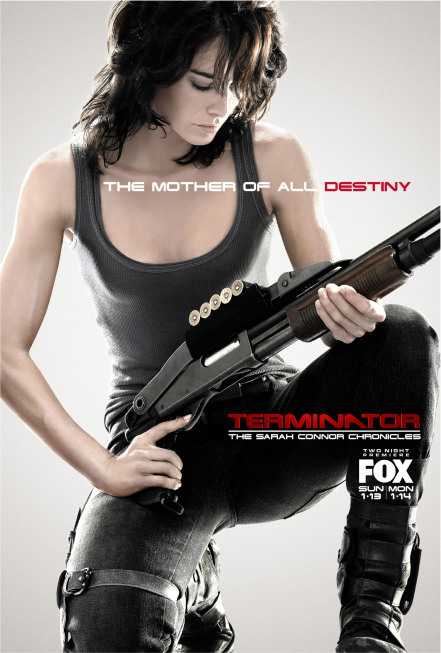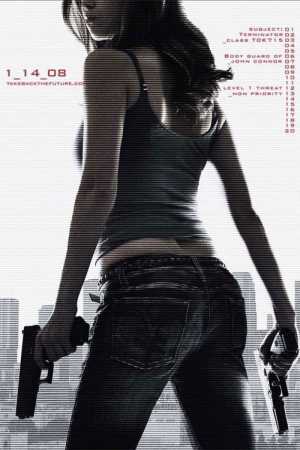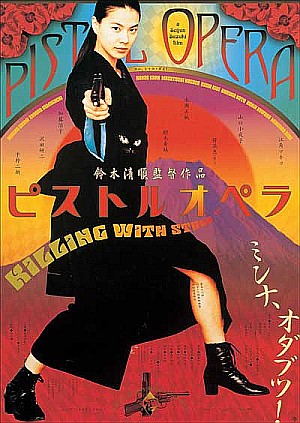★★★½
“Could do with some more action, yet still more than acceptable.”
 The double-pilot. Probably deserving of a place on the FAQ is, “Why don’t you include Sarah Connor?” The reason is simply that she was a supporting character in the first two Terminator films; one essential to the plot, that’s for sure, but clearly over-shadowed by her male counterparts in both movies. The TV series finally moves Connor (Headey) front and center, and also adds an additional action-heroine dimension, in the shape of Cameron Phillips (Glau), a schoolmate of John Connor’s who turns out to be a new model of Terminator, sent back to watch over him. The show starts in 1999, a couple of years after the events of Terminator 2, but soon shifts to the present day; it thus largely ignores the timeline of Terminator 3, in which Sarah Connor was reported to have died of leukemia in 1997.
The double-pilot. Probably deserving of a place on the FAQ is, “Why don’t you include Sarah Connor?” The reason is simply that she was a supporting character in the first two Terminator films; one essential to the plot, that’s for sure, but clearly over-shadowed by her male counterparts in both movies. The TV series finally moves Connor (Headey) front and center, and also adds an additional action-heroine dimension, in the shape of Cameron Phillips (Glau), a schoolmate of John Connor’s who turns out to be a new model of Terminator, sent back to watch over him. The show starts in 1999, a couple of years after the events of Terminator 2, but soon shifts to the present day; it thus largely ignores the timeline of Terminator 3, in which Sarah Connor was reported to have died of leukemia in 1997.
The concept, as explored in the first two episodes, is very familiar: Sarah must protect son John (Dekker), so he can lead the human resistance after Skynet declares war on us. Skynet sends its unstoppable robotic henchmen back in time to take him out, but she also has an unstoppable robot of her own – this Terminator is more advanced than Arnie’s, being capable of ingesting food. However, there is further development, with the interesting idea that the future John Connor has sent back other humans, to provide a support network for Sarah in her struggle. It is only brushed against in the opening two hours, but may be developed in further episodes. There is also an FBI agent (Jones), who has been hunting Connor since her escape from the mental asylum, and her former fiancee, on whom Sarah bailed.
Glau and Headey both have action experience, from their roles in Serenity and 300 respectively, and they bring the necessary resilience to the role. Glau has a balletic grace and flexibility which helps make up for her obvious lack of size, and while there is clearly some body-doubling done, it’s mostly well-handled and the editing of the fight sequences is above-average. We also liked the deadpan portrayal she brings to the role. Headey does not yet exhibit the ferocious passion which Hamilton brought to her role, so that’s something we want to see develop, and we also hope they do not get bogged down and become a ‘Terminator of the Week’ show. It seems that time-travel may be a significant part of the story, and this would open up an almost infinite range of possibilities. This was a solid, entertaining opening, and fingers crossed the rest of the series can build on the potential.
 The rest of the series If there’s an unfinished feel to the show, that would be because it was. Thanks to the writer’s strike, the final four episodes never made it to the screen, and the storylines will be incorporated into the upcoming second series, confirmed by Fox in April. While not perhaps the makers’ fault, it undeniably had an effect, basically leaving us to turn to each other at the end [which involved a car-bomb] and go, “Is that it?” The rest of the series, however, wasn’t so terrible, though it did feel somewhat stretched. The main plot threads were extensions of the pilot: a) the Connors trying to stop Skynet from becoming active, in particular through locating a chess computer called The Turk, and b) evil Terminator Cromartie trying to stop them. There’s also c) an FBI agent (Jones) who is trying to piece together the pieces, trailing both parties, and d) the arrival of Derek Reese, the brother of Kyle and therefore John Connor’s uncle.
The rest of the series If there’s an unfinished feel to the show, that would be because it was. Thanks to the writer’s strike, the final four episodes never made it to the screen, and the storylines will be incorporated into the upcoming second series, confirmed by Fox in April. While not perhaps the makers’ fault, it undeniably had an effect, basically leaving us to turn to each other at the end [which involved a car-bomb] and go, “Is that it?” The rest of the series, however, wasn’t so terrible, though it did feel somewhat stretched. The main plot threads were extensions of the pilot: a) the Connors trying to stop Skynet from becoming active, in particular through locating a chess computer called The Turk, and b) evil Terminator Cromartie trying to stop them. There’s also c) an FBI agent (Jones) who is trying to piece together the pieces, trailing both parties, and d) the arrival of Derek Reese, the brother of Kyle and therefore John Connor’s uncle.
The extra time available to a TV series does allow for expansion, perhaps most notably that Skynet does more to try and affect the past than just send back Terminators – it is supposed to be a super-intelligent system after all. On the other hand, the action elements are significantly reined back, perhaps in association with budget restrictions. However, I particularly liked the SWAT assault on Cromartie in the final episode, set to Johnny Cash’s The Man Comes Around, which I’ve loved since they used it in the opening to the Dawn of the Dead remake. Needless to say, that goes about as well for the SWAT team as you might expect. Glau is particularly good, with her character actually developing in unexpected ways, such as discovering a taste for ballet.
However, there has been a fair bit of sniping regarding Headey, comparing her physical presence unfavourably (the word “weedy” gets used a good deal) with Linda Hamilton’s. Said one such critic: “There are two issues here: having a toothpick-thin, feeble-looking Sarah Connor is a crime against the iconography of the character; and presenting a clearly emaciated actress as a heroine is a crime against women.” Headey’s response was blunt and to the point: “It’s a TV show, for God’s sake!” – and I’m inclined to agree. We’re dealing with a series about time-travelling robots here, folks. If you seek role models for your body here, there’s probably no hope for you. Here’s to the second series, especially if there’s more ass-kicking from Headey and Glau.
Dir: David Nutter and others
Star: Lena Headey, Thomas Dekker, Summer Glau, Richard T. Jones
 I don’t think I have ever been quite so flummoxed by a girls-with-guns film. To say it’s not quite what I expected is an understatement, but it’s also my first experience of Seijun Suzuki, who is one of the icons of Japanese cinema. The basic plot centers around Stray Cat (Esumi), the current #3-ranked assassin; there’s a guild who decide such things, but they are on the edge of anarchy and Cat gets the assignment from her manager (Yamaguchi) to target the #1, Hundred Eyes. However, there are a lot of people with their own agendas, not least Sayoko (Han), a young girl who wants Cat to teach her the ways of murder.
I don’t think I have ever been quite so flummoxed by a girls-with-guns film. To say it’s not quite what I expected is an understatement, but it’s also my first experience of Seijun Suzuki, who is one of the icons of Japanese cinema. The basic plot centers around Stray Cat (Esumi), the current #3-ranked assassin; there’s a guild who decide such things, but they are on the edge of anarchy and Cat gets the assignment from her manager (Yamaguchi) to target the #1, Hundred Eyes. However, there are a lot of people with their own agendas, not least Sayoko (Han), a young girl who wants Cat to teach her the ways of murder.




 These days, the notion of women participating in mixed martial-arts is no longer seen as particularly outlandish, with names like Tara LaRosa, Yuka Tsuji and Megumi Fujii among the top fighters [as with pro wrestling, the best fighters are out of Japan]. However, this wasn’t always the case: In April 2002, in Evansville, Indiana, one of the first all-women events in America took place. The fights took place under
These days, the notion of women participating in mixed martial-arts is no longer seen as particularly outlandish, with names like Tara LaRosa, Yuka Tsuji and Megumi Fujii among the top fighters [as with pro wrestling, the best fighters are out of Japan]. However, this wasn’t always the case: In April 2002, in Evansville, Indiana, one of the first all-women events in America took place. The fights took place under  The double-pilot. Probably deserving of a place on the FAQ is, “Why don’t you include Sarah Connor?” The reason is simply that she was a supporting character in the first two Terminator films; one essential to the plot, that’s for sure, but clearly over-shadowed by her male counterparts in both movies. The TV series finally moves Connor (Headey) front and center, and also adds an additional action-heroine dimension, in the shape of Cameron Phillips (Glau), a schoolmate of John Connor’s who turns out to be a new model of Terminator, sent back to watch over him. The show starts in 1999, a couple of years after the events of Terminator 2, but soon shifts to the present day; it thus largely ignores the timeline of Terminator 3, in which Sarah Connor was reported to have died of leukemia in 1997.
The double-pilot. Probably deserving of a place on the FAQ is, “Why don’t you include Sarah Connor?” The reason is simply that she was a supporting character in the first two Terminator films; one essential to the plot, that’s for sure, but clearly over-shadowed by her male counterparts in both movies. The TV series finally moves Connor (Headey) front and center, and also adds an additional action-heroine dimension, in the shape of Cameron Phillips (Glau), a schoolmate of John Connor’s who turns out to be a new model of Terminator, sent back to watch over him. The show starts in 1999, a couple of years after the events of Terminator 2, but soon shifts to the present day; it thus largely ignores the timeline of Terminator 3, in which Sarah Connor was reported to have died of leukemia in 1997. The rest of the series If there’s an unfinished feel to the show, that would be because it was. Thanks to the writer’s strike, the final four episodes never made it to the screen, and the storylines will be incorporated into the upcoming second series, confirmed by Fox in April. While not perhaps the makers’ fault, it undeniably had an effect, basically leaving us to turn to each other at the end [which involved a car-bomb] and go, “Is that it?” The rest of the series, however, wasn’t so terrible, though it did feel somewhat stretched. The main plot threads were extensions of the pilot: a) the Connors trying to stop Skynet from becoming active, in particular through locating a chess computer called The Turk, and b) evil Terminator Cromartie trying to stop them. There’s also c) an FBI agent (Jones) who is trying to piece together the pieces, trailing both parties, and d) the arrival of Derek Reese, the brother of Kyle and therefore John Connor’s uncle.
The rest of the series If there’s an unfinished feel to the show, that would be because it was. Thanks to the writer’s strike, the final four episodes never made it to the screen, and the storylines will be incorporated into the upcoming second series, confirmed by Fox in April. While not perhaps the makers’ fault, it undeniably had an effect, basically leaving us to turn to each other at the end [which involved a car-bomb] and go, “Is that it?” The rest of the series, however, wasn’t so terrible, though it did feel somewhat stretched. The main plot threads were extensions of the pilot: a) the Connors trying to stop Skynet from becoming active, in particular through locating a chess computer called The Turk, and b) evil Terminator Cromartie trying to stop them. There’s also c) an FBI agent (Jones) who is trying to piece together the pieces, trailing both parties, and d) the arrival of Derek Reese, the brother of Kyle and therefore John Connor’s uncle.